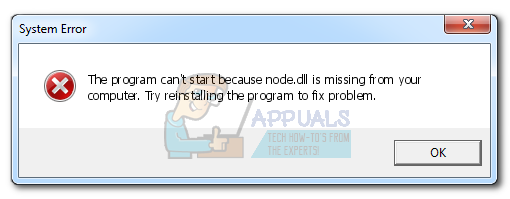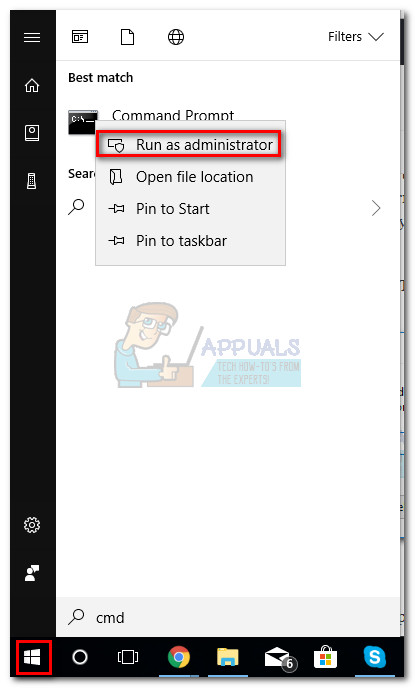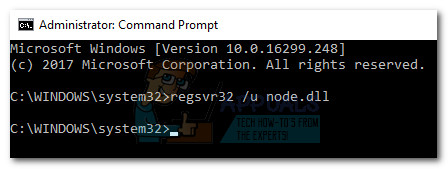Fix: node.dll is missing
The “node.dll is missing” error is likely caused by file corruption that is preventing the system from using the required DLL (Dynamic Link Library). The issue can also arise if node.dll is not yet registered with Microsoft Register Server.

Node.dll is a regular DLL file frequently used on Windows 10 and Windows 8. DLL (Dynamic link library) files such as node.dll are essentially small programs that work similar to executables. Their purpose is to allow multiple independent software programs to share the same functionality across Windows. However, software changes and file corruption might make certain DLL files unusable.
If you’re currently struggling with a “node.dll is missing” error, attempt to fix the issue with one of the methods featured below. Please follow the methods in order and resort to the final Note paragraph for final instructions in case the issue is still not resolved.
Method 1: Run an SFC Scan
Let’s start by eliminating the possibility of corruption causing the node.dll file to misbehave. Running an SFC scan will automatically replace any corrupted files that might be causing the issue.
Note: The SFC (System File Checker) scan is a Windows utility that automatically scans for corruption inside the Windows system files. If any files are found missing, Windows will automatically replace the affected files with a clean version. This also includes DLL files.
Follow the guide below to run an SFC scan and repair corrupted files:
- Click the Start bar in the bottom left corner and search for “cmd“. Then, right-click on Command Prompt and select Run as administrator to open an elevated Command Prompt.
 Note: The SFC scan must be run from an elevated Command Prompt. Otherwise, you will get an “access denied” error.
Note: The SFC scan must be run from an elevated Command Prompt. Otherwise, you will get an “access denied” error. - In Command Prompt, type “sfc /scannow” and hit Enter. This will trigger a system-wide search that will scan for corrupted files. Sit tight and wait for the process to complete as it might take over 20 minutes.
 Note: The SFC scan is known to find and resolve corruption occurrences without ever reporting them. Please continue with the steps below even if it shows that no corruption has been found in the end report.
Note: The SFC scan is known to find and resolve corruption occurrences without ever reporting them. Please continue with the steps below even if it shows that no corruption has been found in the end report. - After System File Checker has finished scanning, run Dism command below and hit Enter:
Dism /Online /Cleanup-Image /RestoreHealth
 Note: This DISM command uses Windows Update (WU) to fetch the files required to fix corruption. Make sure you have a stable internet connection before running the DISM command above.
Note: This DISM command uses Windows Update (WU) to fetch the files required to fix corruption. Make sure you have a stable internet connection before running the DISM command above. - When the scan is finished, reboot your system and see if the issue has been resolved. If it isn’t, move to the second method below.
Method 2: Re-registering node.dll
If the method above was insufficient, let’s troubleshoot further by trying to re-register the node.dll file via an elevated Command Prompt. This will instruct your system to create a registry entry for node.dll, overwriting any registry information that was previously inserted.
Follow the steps below to re-register node.dll via an elevated Command Prompt:
- Click the Start bar in the bottom left corner and search for “cmd“. Then, right-click on Command Prompt and select Run as administrator to open an elevated Command Prompt.

- In the elevated Command prompt, type “regsvr32 /u node.dll” and hit Enter to un-register node.dll.

- Once the node.dll file has been un-registered, let’s register it again by typing “regsvr32 /i node.dll”, and hitting Enter.

- Close the elevated Command Prompt and reboot your PC. When the system boots up again, see whether you’ve managed to resolve your issue.
Note: If you’re getting the “node.dll is missing” error while opening a certain application, make sure you’re not trying to open the executable from a ZIP or RAR archive. If you are, extracting the contents of the archive and opening the executable again will most likely resolve the issue. If that doesn’t work, see whether this was caused by localized corruption by reinstalling the application/game in question.